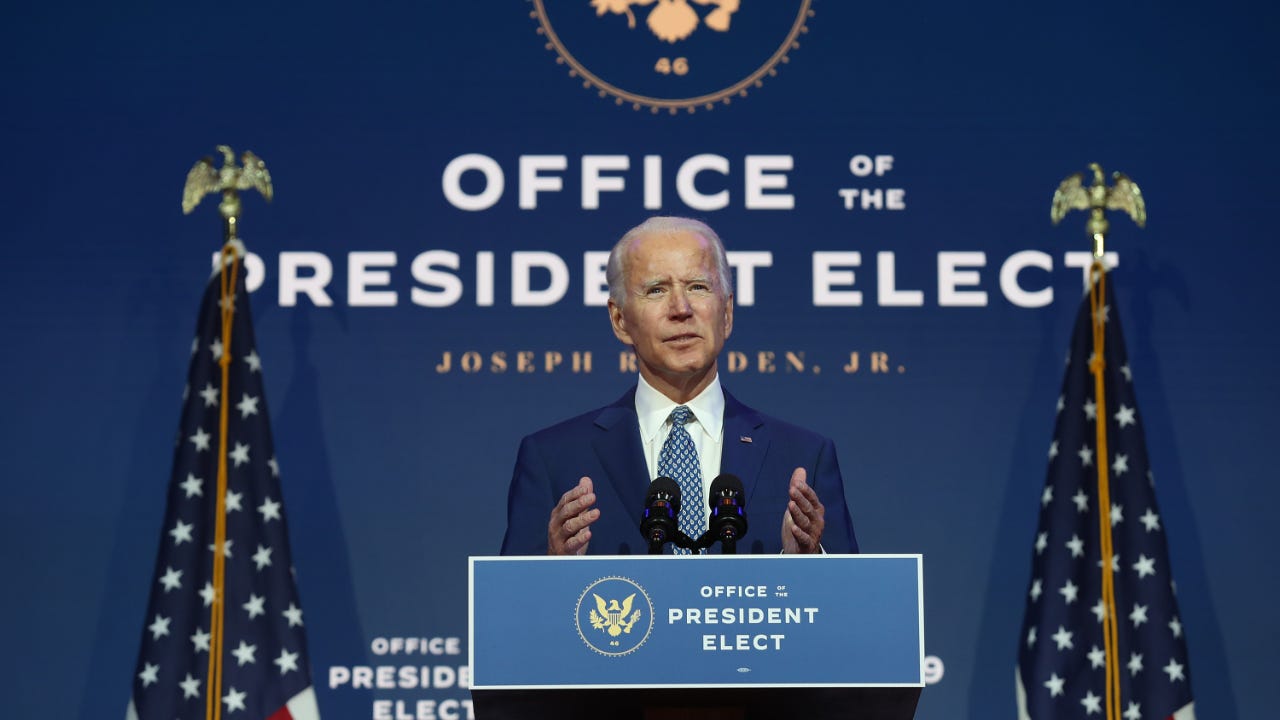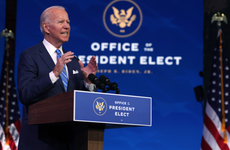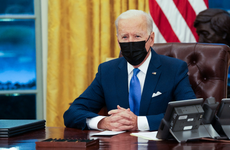What a Biden presidency means for your money, taxes and the economy

The Bankrate promise
At Bankrate we strive to help you make smarter financial decisions. While we adhere to strict , this post may contain references to products from our partners. Here's an explanation for .
The U.S. presidency is set for a tidal shift come January 2021, when former Vice President Joe Biden succeeds President Donald Trump after a Saturday projection showed he was set to win the 2020 race.
Biden will inherit a much weaker economy than Trump did back in 2017, which some experts say may challenge his more progressive policy proposals that include tax hikes on wealthy earners, student loan forgiveness and a public health insurance option similar to Medicare. The fate of those plans also depends on the balance of power within the Senate, which will likely be decided following a January run-off election in Georgia. Trump is also challenging the results of the election and has yet to officially concede.
“Among Joe Biden’s top challenges will be to foster a continued economic recovery including among the substantial number of Americans who were fearful, right or wrong, of his election,” says Mark Hamrick, Bankrate’s senior economic analyst and Washington bureau chief.
Here’s what you need to know about Biden’s wallet-impacting policy proposals and how likely they are to pass once he’s sworn in next January.
1. Biden’s coronavirus and economic stimulus plans
Biden’s top challenge will be getting the U.S. economy back on track. A Bankrate quarterly poll of economists suggests that won’t happen for at least two and a half more years, with job growth momentum slowing and the CARES Act-backed stimulus provisions passed back in March fading away.
The Biden-Harris campaign underscored four “Day One” priorities in a transition website created Monday: handling the coronavirus pandemic, the economic recovery, racial equity and climate change.
The first two priorities go hand in hand, having a sizable impact on your wallet — and they’re also likely to be the biggest priorities for the Biden administration, analysts say.
“Controlling the pandemic, getting a vaccine out, restoring people’s confidence to be back in the marketplace and the labor market will be a huge plus for everyone, but disproportionately more so for folks we would call the average Americans,” says Steve Skancke, chief economic adviser at Keel Point.
Biden’s pandemic-fighting plans include:
- Increasing the availability and reliability of coronavirus testing;
- Boosting personal protective equipment (PPE) production;
- Setting up a reserve of funds for state and local governments to address pandemic-related budget shortfalls;
- Creating a Public Health Jobs Corps to employ at least 100,000 Americans for contact tracing jobs;
- Directing the CDC to issue more specific reopening guidelines;
- Investing $25 billion in vaccine manufacturing and distribution; and
- Allocating funding from Congress to help schools and small businesses cover the cost of plexiglass and other PPE.
Infrastructure plan for stimulus
Biden’s plans to stimulate the economy appear to be two-fold, with the first priority being an infrastructure plan intended to spur job creation, similar to the Great Depression-New Deal era of public job programs.
Those ideas, which form together into a $2 trillion infrastructure plan previously discussed on the campaign trail, include:
- Creating 1 million new jobs in the auto industry by expanding factory floors;
- 250,000 jobs for plugging abandoned oil and natural gas wells;
- Another million jobs for updating homes, transit and buildings to be environmentally friendly and sustainable;
- A separate $700 billion manufacturing program to create what he estimates could be 5 million jobs by investing in American-made products; and
- Tax credits for firms if they expand U.S. operations and hire more workers.
Other plans include creating jobs to update and build smart roads, water systems, municipal transit networks, schools, airports, rails, ferries and increasing broadband access, according to Biden’s campaign website.
The U.S. economy currently has a jobs deficit of about 10.1 million positions from the coronavirus pandemic’s economic effects.
Economic relief similar to the CARES Act
But some experts say stimulating the economy comes after helping U.S. households get through the crisis.
“A near-term priority is getting us into a situation where there is enough cash to go around and keep people functioning basically through this crisis,” says James Knightley, chief international economist at ING. “Then we get in the second phase and that is sustaining the recovery and really building on what we’ve got.”
The CARES Act from March looks to be a blueprint for Biden’s main relief plans, with the Biden-Harris campaign reportedly wanting to:
- Send another round of direct stimulus payments;
- Forgive $10,000 of federal student loans per borrower;
- Boost monthly Social Security checks; and
- Provide emergency paid sick leave to all workers in all industries and sectors.
Top of mind for many Americans is whether — and how much — they’ll receive in another round of payments. The Biden-Harris campaign hasn’t provided information on eligibility for those second checks, though Democrats have been vocal about including incarcerated individuals and those who didn’t have a Social Security number but still paid U.S. taxes. Other Democratic lawmakers have proposed making adult dependents who are over age 17 eligible for the additional $500 check that goes to families who still claim a child on their tax returns.
2. Biden’s tax policy plans
Biden’s plans to fight the coronavirus and the economic recovery come with a big price tag — meaning, odds are, they’ll have to be financed by raising taxes. The U.S. federal deficit in 2020 alone has already soared to its widest level ever, thanks to Congress’ massive response with the CARES Act.
A key Biden campaign message, however, has been that he’s only planning to raise those taxes on the country’s wealthiest earners and corporations. That looks like:
- Everyday Americans: Restoring the top-line tax rate of 37 percent to 39.6 percent, which was reduced after Trump’s Tax Cuts and Jobs Act (TCJA) of 2017. As of 2020 (taxes due in 2021), single filers earning $518,401 or higher and married filers earning more than $622,051 are currently taxed at the top-line rate of 37 percent.
- Corporations: Raising the corporate tax rate from 21 percent to 28 percent, introducing a 15 percent minimum “book” profit tax on companies that earn more than $100 million a year in revenue; making employers pay payroll taxes on wages at or above $400,000 a year (Currently, those taxes are capped on earnings of $137,700).
- Investments: Taxing capital gains as income, regardless of whether they’re a short-term or long-term investment, on earners who make more than $1 million annually; eliminating a “step-up in basis” that allows descendants to pass those investments to heirs tax free.
A more stimulative aspect of Biden’s tax plans, the president-elect supports amping up a child care tax credit that families with dependents up to 13 years in age can use to subsidize half of their child care costs, as long as it doesn’t exceed $8,000 for one child or $16,000 for two children. Families making less than $125,000 annually would be eligible for the full 50 percent credit. After that threshold, a partial credit would be available to individuals whose incomes come in under $400,000.
Biden has also floated the idea of providing a $15,000 tax credit to first-time homebuyers to help them with their first property purchase, similar to the Great Recession-era program meant to get the housing market back on track.
3. Biden’s student loan policies
The rest of Biden’s wallet-impacting policies weren’t listed as a priority on the Biden-Harris transition website, meaning they might not be something you can expect within the first 100 days — or even the first year — of the Biden administration.
Student loans were a hot-button item for younger voters, particularly as Biden sought to win over the college aged progressives who supported Sens. Elizabeth Warren and Bernie Sanders’ bids for the Oval Office in 2021.
The most substantial student loan forgiveness proposal comes from Biden’s coronavirus stimulus proposals. However, the president-elect has also proposed making it easier for lower-income and middle-class families to attend community colleges and universities, while adjusting the way lower-income filers make their payments once those federal student loans are in repayment.
- Tuition: Making community college and other career training programs that are considered “high quality” tuition-free through a jointly funded federal-state partnership; and making public colleges and universities tuition-free exclusively for families whose incomes fall below $125,000.
- Student loan payments: Exempting individuals who earn $25,000 or less a year from having to owe payments on their undergraduate federal student loans and preventing interest from accruing during that time; allowing earners who make more than $25,000 a year to only pay 5 percent of their discretionary income on their student loans and then have that balance forgiven after 20 years
- Loan forgiveness: Creating a program that provides $10,000 in student loan debt relief for every year a borrower works in national or community service, up to five years; and having individuals who work for a federal, state, local or tribal government or another nonprofit for 10 years have their balances forgiven.
4. Biden’s health care plans
Few policies divided Democrats in the run up to the 2020 primaries more than health care.
While Biden is seen as more of a centrist when it comes to health care policy, rejecting Sanders’ plans to create a “Medicare For All” system, Biden’s main plans seem focused on expanding the Obama-era Affordable Care Act while still granting Americans free reign over whether they want to seek a public health insurance plan or their own coverage on the marketplace.
As discussed on the campaign trail, Biden has talked about:
- Issuing an executive order to bring back the individual mandate that Trump repealed, which is designed to incentivize taxpayers to enroll in a program by charging them a fine if they’re not enrolled;
- Creating a public health insurance option similar to Medicare that all Americans would be eligible for, though they’d still have the option to choose their own health care provider or another insurance program that’s available to them;
- Prevent Americans from having to pay a copay on primary care and from having to spend more than 8.5 percent of their income on coverage;
- Removing a 400 percent income cap that determines whether an individual can utilize a tax credit, meant to help reduce insurance premiums;
- Introducing initiatives to help lower prescription drug prices, which include allowing American consumers to buy prescription drugs from other countries, limiting price hikes that exceed overall inflation rate on all “brand, biotech and abusively priced generic drugs” and appointing the Secretary of Health and Human Services to launch a review board that would assess the value of a drug coming onto market that doesn’t have much competition.
5. Biden’s Social Security plans
Social Security is facing longer-run challenges that Biden will be forced to grapple with, many of which are bound to be exacerbated by the coronavirus pandemic. The population is aging dramatically, while the Social Security Trustees project estimates that unfunded obligations over the next 75 years will swell to $16.8 trillion. Some experts also forecast that insolvency problems will happen much sooner than originally estimated, with mass unemployment weighing on payroll tax revenues.
Biden’s main plan of addressing the solvency issue appears to be part of his tax policy proposals, particularly by making employers pay the 12.4 percent Old-Age, Survivors and Disability Insurance (OASDI) levies on higher-income wages typically ineligible.
Beyond that, however, Biden isn’t proposing any cuts to the system or ideas such as “means-testing” and is instead floating the following expansions:
- Providing the country’s oldest Americans with a higher benefit if they’ve been making payments for at least 20 years;
- Offering Americans who’ve worked for at least 30 years a benefit that’s 125 percent of the federal poverty level;
- Increasing benefit amounts for survivors or widowed spouses by about 20 percent per month;
- Basing cost-of-living adjustments off the Consumer Price Index for the elderly (CPI-E);
Beyond Social Security, Biden has also talked about providing up to $5,000 in tax credits to caregivers who are taking care of their elderly spouses or parents, incentivizing small businesses to create retirement accounts so more people enroll in a plan and shaking up tax incentives on 401(k) retirement accounts to make deductions among both lower- and higher-income earners are more equal.
What are the odds that a number of these proposals get passed?
If you’re hoping for dramatic health care, Social Security or student loan changes, experts say you might have to be patient. That’s because Biden is going to confront significant challenges in getting his proposals through, particularly if Republicans maintain control of the Senate.
At the same time, the economy’s fragile rebound might make even middle-of-the-road Democrats hesitant about raising taxes, which would sap away some power from any major infrastructure or relief stimulus plans.
“When we talk about Biden’s economic policies, to me this is going to be ‘Biden Lite,’” says Gary Schlossberg, global strategist at the Wells Fargo Investment Institute. “Many of the policies that he’s proposed are pretty much out the window.”
Schlossberg sees Biden using his 47 years as a legislator in Washington to his advantage, perhaps having to negotiate with Republican and “purple” Democrats by giving some of his proposals up in order to send others through. One such example could be agreeing to ramp up defense spending, piggybacking his own policy proposals off of Republican-supported ideas or making some of the TCJA’s tax cuts permanent, which are currently set to expire after 2025, in exchange for spending on some of his other desired programs, Schlossberg says.
While some of Biden’s proposals, particularly in the retirement and Social Security space, appear to have more bipartisan support, Republicans wary of government spending might want to make sure they sign on to a bill that provides the most bang for the buck.
“If the Republicans retain control of the Senate, the deficit hawks are going to be standing there with their calculators and saying, ‘OK, look, we have so much that we can spend,’” Skancke says. “‘Do we want to spend it on infrastructure? Do we want to spend it on expanding health care? Do we want to spend it on forgiving student loans? Where do we think that we get the biggest benefit as we’re coming out of a recession?’ And that will be the challenge for Vice President Biden as he assumes leadership.”
Biden could use executive orders to sidestep Congress
Trump’s final year in office illustrated just how powerful the executive branch can be when taking the right steps, with the chief executive signing four different executive mandates that included expanding weekly unemployment insurance (UI) payments and extending a federal student loan forbearance program as Congress remained gridlocked. Experts say Biden could choose to use those to his advantage, particularly for his regulation agenda, though they wouldn’t be as powerful as getting Congress on board for a bill.
There’s also a chance that Congress reaches a stimulus deal before Biden officially takes office. Treasury Secretary Steven Mnuchin and House Speaker Nancy Pelosi have been attempting to forge differences in stimulus proposals for nearly seven months now, after passing the $2 trillion CARES Act in March.
Democrats, Republicans and White House officials have differing priorities, with Republicans preferring “skinny” stimulus bills to avoid exacerbating U.S. public debt. The Trump administration, meanwhile, is reportedly willing to spend another $1.8 trillion and Democrats closer to $2.2 trillion on a second major coronavirus crisis response. That also might be hard, in a lame-duck period in Washington.
All of these negotiations are happening as coronavirus cases are surging again, averaging out to more than 116,000 nationwide over the past week, according to a New York Times tracker. Economists say the economy can’t fully rebound until the virus is under control, meaning less room for Biden to advance some of his policy proposals that don’t have anything to do with the virus.
“There’s going to be more pain in the near-term, and that’s going to hurt jobs and hurt the economy,” Knightley says. “It means Joe Biden has an even more challenging job next year.”
Learn more:
- Second stimulus check: With no relief in sight, here are 6 places to turn for financial help
- Coronavirus hardship loans: What you need to know
- 13 steps to take if you’ve lost your job due to the pandemic
Related Articles

Biden vs. Trump on creating jobs: Here’s how they plan to battle coronavirus-driven recession


$1,400 stimulus check and $400 weekly unemployment boost: Here’s what’s in Biden’s plan

Biden’s tax plan: Watch for these expanded breaks soon and possible hikes later